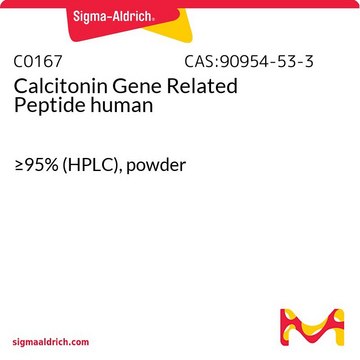C0292
Calcitonin Gene Related Peptide rat
≥95% (HPLC), powder
Synonym(s):
α-CGRP, CGRP-I
Sign Into View Organizational & Contract Pricing
All Photos(1)
About This Item
Empirical Formula (Hill Notation):
C162H262N50O52S2
CAS Number:
Molecular Weight:
3806.25
MDL number:
UNSPSC Code:
51111800
NACRES:
NA.32
Recommended Products
biological source
rat
Quality Level
Assay
≥95% (HPLC)
form
powder
mol wt
3803.25-3809.25 Da
technique(s)
cell based assay: suitable
sequence note
Ser-Cys-Asn-Thr-Ala-Thr-Cys-Val-Thr-His-Arg-Leu-Ala-Gly-Leu-Leu-Ser-Arg-Ser-Gly-Gly-Val-Val-Lys-Asp-Asn-Phe-Val-Pro-Thr-Asn-Val-Gly-Ser-Glu-Ala-Phe-NH2
storage temp.
−20°C
Gene Information
rat ... Calca(24241)
Looking for similar products? Visit Product Comparison Guide
Amino Acid Sequence
Ser-Cys-Asn-Thr-Ala-Thr-Cys-Val-Thr-His-Arg-Leu-Ala-Gly-Leu-Leu-Ser-Arg-Ser-Gly-Gly-Val-Val-Lys-Asp-Asn-Phe-Val-Pro-Thr-Asn-Val-Gly-Ser-Glu-Ala-Phe-NH2
General description
Research area: Neuroscience
Calcitonin gene related peptide (CGRP) is a 37 amino acid neuropeptide. It exists in two isoforms α-CGRP and β-CGRP. CGRP is produced by the alternative splicing of the calcitonin gene (CALCA). They are primarily localized in the C and Aδ sensory fibers, but are also present in non-neuronal tissues, like the cardiovascular system.
Calcitonin gene related peptide (CGRP) is a 37 amino acid neuropeptide. It exists in two isoforms α-CGRP and β-CGRP. CGRP is produced by the alternative splicing of the calcitonin gene (CALCA). They are primarily localized in the C and Aδ sensory fibers, but are also present in non-neuronal tissues, like the cardiovascular system.
Application
Calcitonin Gene Related Peptide rat has been used:
- To study its protective role in lipopolysaccharide (LPS)-induced acute lung injury (ALI).
- To examine the effects of calcitonin gene related peptide (CGRP) and salmon calcitonin (sCT) on gastric lesions and mucosal barrier in stress induced rats.
- To mediate the complement component 5a (C5a) induced mechanical hypersensitivity by activating nerve fibers and influencing non-neuronal cell movement through its receptor.
Biochem/physiol Actions
Calcitonin gene related peptide (CGRP) is a potent vasodilator produced from sensory fibers, acting as transmitters in the peripheral and central nervous system, thereby exerting its role in regulating pain and cardiovascular activity. CGRPs play an important role in regulating systemic blood pressure, and microvascular dilatation and are associated with hyperemia. It stimulates edema in orofacial tissue and its activation in pancreatic β-cells increases plasma levels of pancreatic enzymes. In addition, CGRP also induces DNA synthesis and cell proliferation in endothelial cells.
Potent, long-lasting vasodilator; activation of CGRP receptors on pancreatic β-cells increases plasma levels of pancreatic enzymes.
Other Notes
Lyophilized from 0.1% TFA in H2O
Storage Class Code
13 - Non Combustible Solids
WGK
WGK 3
Flash Point(F)
Not applicable
Flash Point(C)
Not applicable
Personal Protective Equipment
dust mask type N95 (US), Eyeshields, Gloves
Choose from one of the most recent versions:
Already Own This Product?
Find documentation for the products that you have recently purchased in the Document Library.
Customers Also Viewed
Exogenous alpha-calcitonin gene-related peptide attenuates lipopolysaccharide-induced acute lung injury in rats
Yang W, et al.
Molecular Medicine Reports, 12(2), 2181-2188 (2015)
Calcitonin gene-related peptide is a potent vasodilator
Brain SD, et al.
Nature, 313(5997), 54-54 (1985)
Effects of salmon calcitonin and calcitonin gene related peptide (CGRP) on gastric mucosal barrier in stress induced rats
Kanay Z, et al.
African Journal of Biotechnology, 8(8) (2009)
Effect of calcitonin gene-related peptide on anastomotic healing in the presence of endotoxin
Dogmucs M, et al.
ANZ Journal of Surgery, 75(12), 1106-1110 (2005)
Charles A Warwick et al.
Pain, 160(3), 702-711 (2018-12-07)
The complement system significantly contributes to the development of inflammatory and neuropathic pain, but the underlying mechanisms are poorly understood. Recently, we identified the signaling pathway responsible for thermal hypersensitivity induced by the complement system component C5a. Here, we examine
Our team of scientists has experience in all areas of research including Life Science, Material Science, Chemical Synthesis, Chromatography, Analytical and many others.
Contact Technical Service









